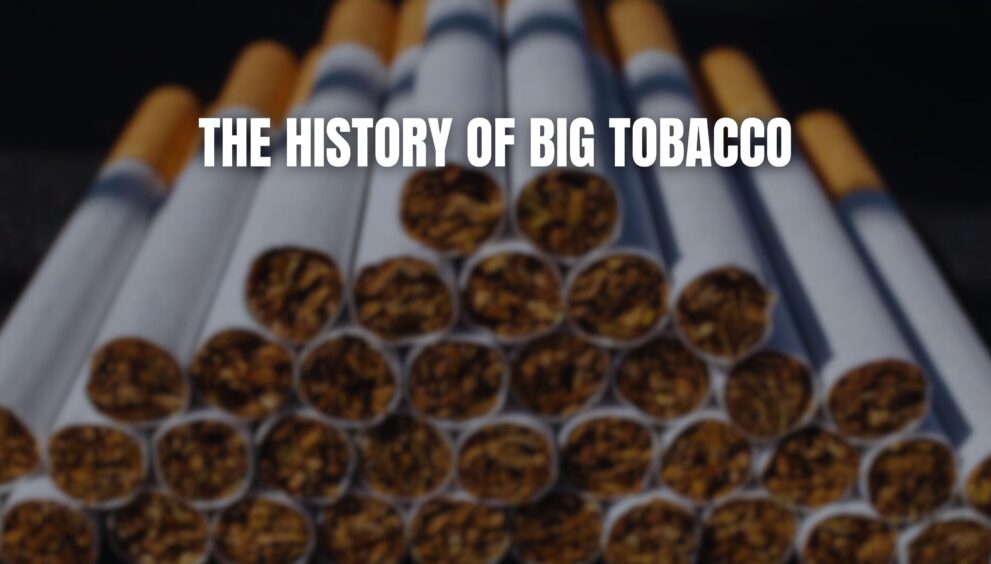We are still looking at diabolical corporations. Thus far, we’ve conducted expose on diabolical food corporations such as Cargill, Nestle and Coca-cola, as well as chemical companies, such as DuPont, Dow, and Bayer. Well, we cannot talk about diabolical conglomerates and not talk about Big Tobacco. Not only was this industry of diabolical corporations culpable in the curation of health issues, but they also employed marketing tactics that fueled the ills of the food industry.
Today, we will address 3 questions, namely: (1) What is the origin story of the tobacco industry? (2) What is big tobacco’s reputation in industry and marketing tactics? And (3) How did big tobacco’s marketing tactics influence diabolical conduct in the food industry?
THE ORIGINS OF THE BIG TOBACCO INDUSTRY
And now onto the first question, being: What is the origin story of the tobacco industry? Well, tobacco was first used around 5000 to 3000 years ago. The native peoples of Mesoamerica and South America discovered tobacco and this is also where it was first grown. The two species that were domesticated, and that historically represent the majority of consumption worldwide, are Nicotiana rustica and Nicotiana tabacum, however, there are wild species that have been used on other continents to a lesser extent.
Then, the arrival of Christopher Columbus to America in 1492 marks the moment when Europeans learned about the tobacco plant and the several ways the natives invented to consume it. Back then tobacco leaves were already smoked, used as snuff, chewed, licked, included in drinks, and used to produce aromatic smoke in religious ceremonies and medicinal rituals. From then on, Europeans began to import tobacco grown in the New World to use it mainly as snuff and smoke it in pipes, where it became very popular for its stimulating effects.
Then, in the US, tobacco manufacturing was further developed largely by men who had experience in growing and selling tobacco or who had lived on farms where tobacco was raised. There were many small tobacco factories in counties along the Virginia border-especially Granville, Person, Caswell, Rockingham, and Stokes; as well as Burke, Iredell, Orange, Rowan, and other counties before 1840. But it took the visits of Confederate and Union armies to the Piedmont, particularly to Durham, to popularise these products. During the American Civil War, especially in 1865 when Union general William T. Sherman’s troops invaded the state, soldiers discovered the quality of bright leaf smoking tobacco. The idle troops-pending arrangement of terms between Sherman and Confederate general Joseph E. Johnston at Bennett Place, well they looted John R. Green’s tobacco factory at Durham. They were said to have found Bull Durham Smoking Tobacco to be the mildest and best they had ever tried.
Then after the American civil war, the soldiers began writing back to Durham for more bright leaf products. And this is where the tobacco industry shed its local character and began its rise to national importance. The Dukes-Washington and sons Benjamin N., James B. “Buck”, and Brodie L. – were among the first to take advantage of this new demand. Washington Duke, mustered out of the Confederate army, returned to his farm near Durham, where he found that some tobacco had been overlooked by the marauding soldiers. He began grinding tobacco, which he packed and sold under the brand name Pro Bono Publico to soldiers and the public. By 1874 Duke and his sons were manufacturing smoking tobacco.
That year R. J. Reynolds also built his first factory in Winston. James B. Duke decided to start making cigarettes, which by 1880 (following their first commercial production, being rolled by hand, in New York about 1864) had become economically important. Although crude cigarette-making machines had been invented in the United States in the 1870s, a more practical device with which to roll cigarettes was invented by James A. Bonsack, a Virginian. That machine-capable of turning out 120,000 cigarettes a day, the equivalent of 40 steady hand rollers working 10 hours-was set up in the W. Duke, Sons and Company factory in 1884. The Duke firm thus gained a great commercial advantage over competitors.
By the turn of the twentieth century, North Carolina was internationally recognized as America’s leading source of tobacco. Even though it was widely known as “Virginia bright leaf,” European customers still understood the North Carolina origins and looked to the state as the world’s major supplier. Cigarettes were fast replacing cigars and chewing tobacco as the most popular means of tobacco consumption in the United States. Interested in forming a combination of the larger cigarette manufacturers, James B. Duke played a key role in organizing the American Tobacco Company, of which he became president, in 1890. In the following years, American Tobacco and its various offshoots gained control of the market not only for cigarettes but also for smoking tobacco, snuff, and practically all tobacco products except cigars.
But, then the federal government’s antitrust action against this corporate giant was launched in 1907 and ended in 1911, when the Supreme Court ordered its dissolution. The old American Tobacco and its closely related subsidiaries were divided into a new American Tobacco Company, Liggett-Myers, P. Lorillard, Philip Morris, Brown and Williamson, and R. J. Reynolds. Following this, James B. Duke soon disassociated himself from the tobacco industry and joined brother Benjamin and George W. Watts in the development of hydroelectric power. But, here’s more on the origins of the tobacco industry.
THE HISTORY OF BIG TOBACCO’S CONCERNING INDUSTRY AND MARKETING TACTICS
This brings us to our second question, being: What is big tobacco’s reputation in industry and marketing tactics? By late 1953, the tobacco industry faced a crisis of cataclysmic proportions. Smoking had been categorically linked to the dramatic rise of lung cancer. Although health concerns about smoking had been raised for decades, by the early 1950s there was a powerful expansion and consolidation of scientific methods and findings that demonstrated that smoking caused lung disease as well as other serious respiratory and cardiac diseases, leading to death. These findings appeared in major, peer-reviewed medical journals as well as throughout the general media.
Well, as a result, the tobacco industry would launch a new strategy, largely unprecedented in the history of US industry and business: it would work to erode, confuse, and condemn the very science that now threatened to destroy its prized, highly popular, and exclusive product. But this would be no simple matter. After all, in the immediate postwar years—the dawn of the nuclear age—science was in high esteem. The industry could not denigrate the scientific enterprise and still maintain its public credibility, so crucial to its success.
Now, at this point, the tobacco industry already had a long history of innovative advertising, marketing, and public relations that had centered on making smoking universal. Starting in the late 19th century, the industry transformed itself to become a model of modern industrial organisation and consumer marketing. The industry took a product that had existed at the cultural periphery and remade it into one of the most popular, successful, and widely used items of the early 20th century. The basic tenet of the highly articulated public relations approach the companies deployed centered on the notion that if the current cultural context was inhospitable to the product, one could—through shrewd and creative public relations interventions—change the culture to fit the product.
It was this approach to “engineering” the culture and consumer consent that would fundamentally inform the industry’s approach to the crisis of the 1950s. After all, if public relations could engineer consent among consumers, so too could it manage the science that was now threatening to undermine the tobacco industry’s product and the entire industry itself. And yet, as subsequent history would show, the management of culture and social meaning was considerably different from the management of science.
Ultimately, the tobacco industry’s program to engineer the science relating to the harms caused by cigarettes marked a watershed in the history of the industry. It moved aggressively into a new domain, the production of scientific knowledge, not for purposes of research and development but, rather, to undo what was then known: which is that cigarette smoking was culpable in a lethal disease.
HOW BIG TOBACCO INFLUENCED THE CREATION OF BIG FOOD
Which then brings us to our final question, being: How did big tobacco’s marketing tactics influence diabolical conduct in the food industry? “Betcha can’t eat just one!” was more than just a 1960s slogan for potato chips. It was part of a concerted effort to engineer junk food loaded with fat, and refined carbohydrates in combinations that are irresistible to people because they trigger the brains’ reward system.
Well, these habit-forming foods were created by the same companies that brought to market addictive cigarettes! New research reveals that, after the government moved to regulate the tobacco industry in the 1960s, tobacco companies responded by investing heavily in food manufacturing to hook new customers. What tobacco companies chose to create in their newly acquired food companies was highly processed food that’s as addictive as tobacco. And guess what? These combinations don’t really exist in nature, and so human bodies were NOT ready to handle them. More specifically, ultra-processed foods can excessively trigger the brain’s reward system… which is why they are difficult for some to resist. Furthermore, these foods have combinations of ingredients that create effects you do not get when you eat those ingredients separately.
Ultimately, tobacco companies like Philip Morris — which owned Kraft Foods and General Foods — and R.J. Reynolds, who owned Del Monte Foods and Nabisco, began to research ways to make their foods irresistible. BUT, around the same time that tobacco companies bought food makers, rates of obesity — and the subsequent increased risk for heart disease, stroke and diabetes — jumped across the US! But, here’s more on how big tobacco influenced the diabolical conduct in big food.
The notion that science can be manipulated to present an outcome desired by an industry has been consistent with the various diabolical corporations and industries we’ve discussed: from the Monsanto Papers exposing that Monsanto paid for research and peer reviewed studies that claimed glyphosate was safe, to the sugar industry paying Harvard researchers to shift the blame from sugar or fats. Well, it so happens that this practice just might have come from big tobacco after all. Not only did they manipulate science to sell more cigarettes, but they have leveraged the science of addiction to also sell harmful ultra-processed foods.
Written By Lindokuhle Mabaso



